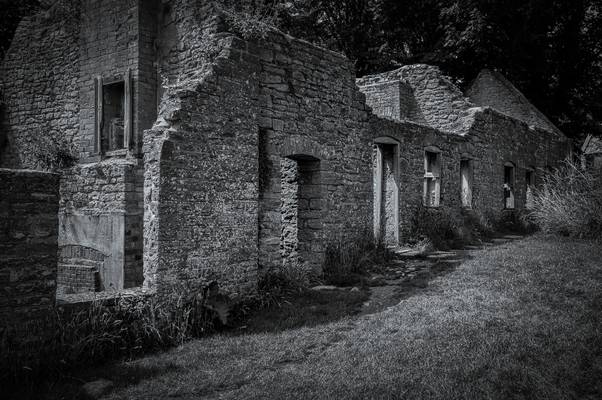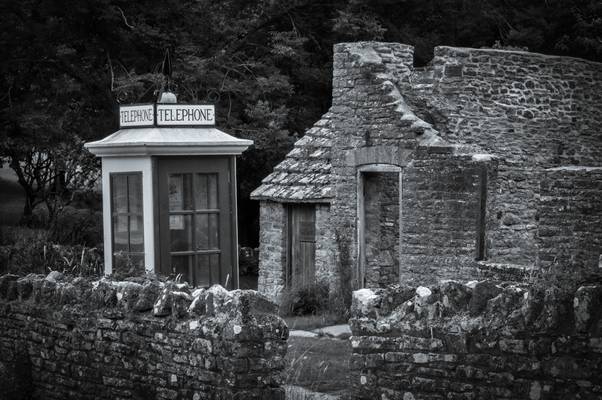
Tyneham Gwyle

by Alan Taylor
My website: Deep Mono Photography
The "ghost village" of Tyneham, and 7,500 acres of surrounding heathland and chalk downland around the Purbeck Hills, were commandeered just before Christmas 1943 by the then War Office (now MoD) for use as firing ranges for training troops. 225 people were displaced, the last person leaving a notice on the church door:
"Please treat the church and houses with care; we have given up our homes where many of us lived for generations to help win the war to keep men free. We shall return one day and thank you for treating the village kindly."
This measure was supposed to be temporary for the duration of World War II, but in 1948 the Army placed a compulsory purchase order on the land and it has remained in use for military training ever since. Though littered with scrap used as targets, and subject to regular shelling, the land has become a haven for wildlife as it has been free from farming and development. In 1975, after complaints from tourists and locals, the Ministry of Defence began opening the village and footpaths across the ranges at weekends and throughout August. Many of the village buildings have fallen into disrepair or have been damaged by shelling and in 1967 the then Ministry of Works pulled down the Elizabethan manor house, though the church remains intact, and has a stained-glass window by Martin Travers. The church and school house have since been preserved as museums. In 2008, Tyneham Farm was reopened to the public and conservation work there is ongoing.
Tyneham Valley was evacuated during the second world war and for the next forty years the abandoned kiosk was left to its fate, hidden under the shade of self seeded trees and disappearing under the sea of undergrowth which had consumed most of the village.
In the early 1980's, prolonged protest and campaigning resulted in the public being granted increased access to the Army Ranges. In 1983 the kiosk was restored as part of a massive clear up programme but with the incorrect K1 roof decor.

by Alan Taylor
My website: Deep Mono Photography
Tyneham got its first public telephone kiosk during the winter of 1929. Before this date the villagers would keep in touch with the outside world by telegram or later by using the telephone in the back room of the Post Office.
Tyneham Valley was evacuated during the second world war and for the next forty years the abandoned kiosk was left to its fate, hidden under the shade of self seeded trees and disappearing under the sea of undergrowth which had consumed most of the village.
In the early 1980's, prolonged protest and campaigning resulted in the public being granted increased access to the Army Ranges. In 1983 the kiosk was restored as part of a massive clear up programme but with the incorrect K1 roof decoration.
During the filming of "Comrades" in 1985 an accident resulted in the kiosk being completely destroyed.The K1 Mark 236 at Tyneham today is the replacement bought by the film company.
In 2012, eighty three years after a K1 was first erected on the site, the kiosk is having a complete makeover. Thanks to the invaluable help of ex-GPO engineer Ian Jolly the Tyneham K1 will soon boast authentic fittings and wartime notices and will look much as it did when the last villager left the valley on 19 December 1943. Tyneham and Worbarrow
The "ghost village" of Tyneham, and 7,500 acres of surrounding heathland and chalk downland around the Purbeck Hills, were commandeered just before Christmas 1943 by the then War Office (now MoD) for use as firing ranges for training troops. 225 people were displaced, the last person leaving a notice on the church door:
"Please treat the church and houses with care; we have given up our homes where many of us lived for generations to help win the war to keep men free. We shall return one day and thank you for treating the village kindly."
This measure was supposed to be temporary for the duration of World War II, but in 1948 the Army placed a compulsory purchase order on the land and it has remained in use for military training ever since. Though littered with scrap used as targets, and subject to regular shelling, the land has become a haven for wildlife as it has been free from farming and development. In 1975, after complaints from tourists and locals, the Ministry of Defence began opening the village and footpaths across the ranges at weekends and throughout August. Many of the village buildings have fallen into disrepair or have been damaged by shelling and in 1967 the then Ministry of Works pulled down the Elizabethan manor house, though the church remains intact, and has a stained-glass window by Martin Travers. The church and school house have since been preserved as museums. In 2008, Tyneham Farm was reopened to the public and conservation work there is ongoing. Wikipedia
Thanks to all Phoide contributors to Tyneham Gwyle!
Most notably Alan Taylor.